DITA CMS Solutions
We will solve internal document-related challenges by combining the document technology cultivated by Human Science over many years with the latest technology that realizes business efficiency.
For those facing such challenges
I want to fundamentally solve the issues with the manuals. What should I do...
- I want to efficiently manage large volumes of documents
- - Want to reduce costs
- ・Want to obtain a production process (translation and writing) that accommodates short delivery times
- ・Aiming to standardize the quality of documents (eliminating variations in expression)
How can we implement the most suitable CMS for our company...
- - Want to implement a CMS, but cannot find the best CMS for our company
We have introduced DITA, but...
- - On the contrary, it is incurring more costs and effort.
- - The translation quality has decreased compared to before implementation
- - Unable to reuse effectively, leading to decreased efficiency
- ・The CMS implemented for utilizing DITA is difficult to use
To solve these concerns, Human Science conducts detailed issue analysis and proposes the optimal workflow tailored to our clients. The key to this is the effective use of DITA and CMS. By combining these, we will lead our clients to solutions for their challenges.

Human Science DITA and CMS Solutions
At Human Science, we define the steps toward problem-solving in five STEPS. Here, we will explain them in order.

 Do you have any of these concerns?
Do you have any of these concerns?
-
Despite the effort required for creating and managing manuals, they are not utilized sufficiently, resulting in a low cost-effectiveness.
"We implemented DITA, but it seems we are not achieving the expected results."
Are you considering implementing DITA to fundamentally solve the issues with the operation of your manuals?
Or, do you feel that although you have implemented DITA, the operation is not going well?
These concerns are issues at the stage of 'analysis and design'.
 This is how to solve it with human science!
This is how to solve it with human science!
-
If the implementation of DITA is not successful, the primary reason is
The goal and quality standards have not been set and shared in advance.
Human Science supports the establishment of appropriate processes and rules to successfully implement DITA.

- 1. Document Structure Analysis and Report
-
We will analyze the current manual structure in detail and report on issues and areas for improvement.
 DITA Suitability Assessment
DITA Suitability AssessmentWe will determine whether the current manual is suitable for a "book-oriented" or "topic-oriented" document and report the analysis results.
[Example of a Report]
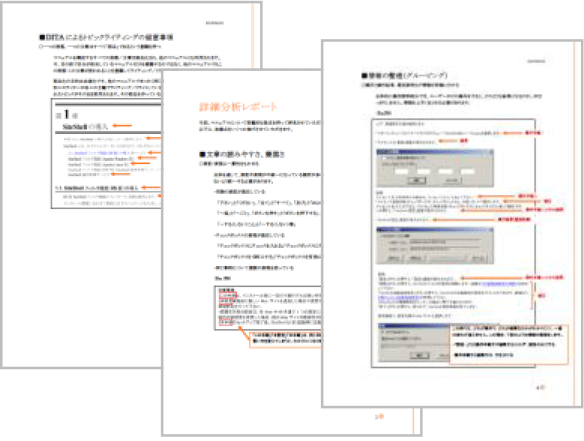
 Suggestions for Improvement
Suggestions for ImprovementI will report the points for rewriting from the following perspectives.
- - Variations in notation
- - Duplicate Expressions
- ・Redundant Expressions
- Information Grouping
- Organization of Procedures
- ・Unnecessary demonstrative pronouns, etc.
- 2. Workflow Analysis and Proposal (Workflow, CMS, Cost)
-
We will listen to the current challenges in document production and clarify the issues from the perspectives of structure, workflow, and cost. Based on that, we will propose the optimal workflow and CMS for our clients.
[Example of a Proposal]
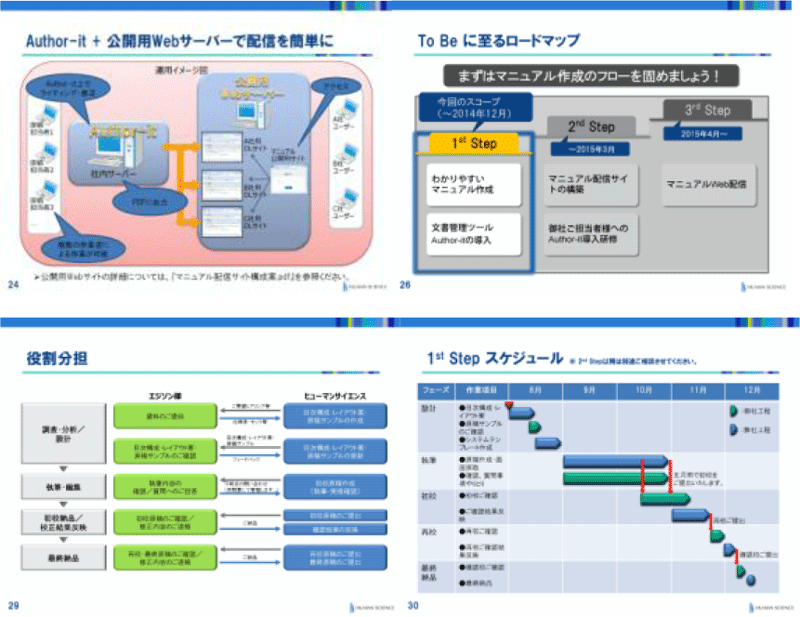
 Do you have any of these concerns?
Do you have any of these concerns?
-
It is difficult to properly manage content that is subdivided by topic (latest management, status management)
It is difficult to work in parallel with multiple people.
"It is difficult to understand the usage status of topics and images across multiple models and their sharing status between models on the instruction manuals."
"Managing translations is cumbersome (especially tracking the correspondence from the source language to each target language is complicated)"
"With existing CMS, we cannot utilize our company's document assets"
Such concerns can be attributed to the absence of a CMS or its ineffective utilization.
 This is how to solve it with human science!
This is how to solve it with human science!
-
To effectively operate DITA, it is important to utilize a CMS and manage document assets effectively.
You can expect the following benefits from the implementation of a CMS.
- - Reliable and up-to-date management is possible
- ・Accurately understand the usage/sharing status of topics
- - Easy to understand the work stages
- ・Organizational management of translation sections
At Human Science, we propose the optimal method for implementing a CMS based on your company's challenge analysis.
We can offer proposals ranging from CMS packages to custom development, tailored to cost benefits and needs.

- A. Package & Customization
-
We will select the optimal CMS package tailored to your needs and implement the necessary customizations to achieve a cost-effective CMS implementation.
Each product has its own features in the CMS (see the table below).
How to leverage the features of each product determines the success or failure of CMS implementation. Human Science has extensive know-how and experience in this area.
Comparison of Features/Products of Representative CMS
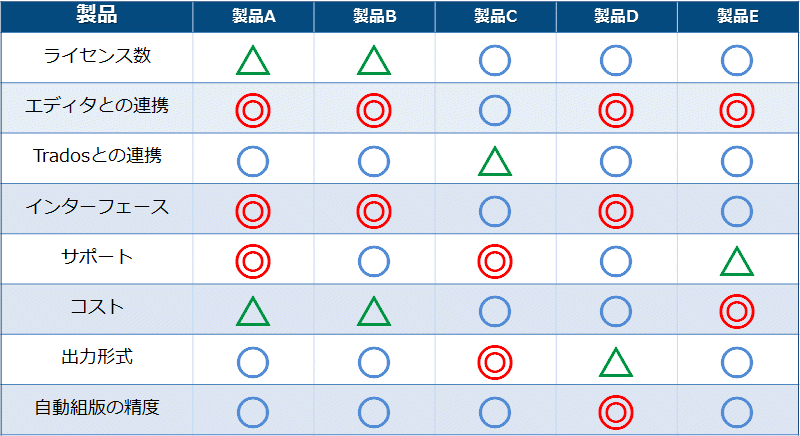
- B. Scratch Development
-
We will build a CMS that fully covers your unique needs through scratch development without using a CMS package.
■Benefits of HS Scratch Development
Point1
There is no need to change the flow as we can design a system that aligns with the current business workflow.
Point2
We can implement the optimal features according to your requests and challenges regarding the documentation.
Point3
At HS, we also offer consulting for the implementation of packaged CMS as needed. Therefore, in cases where a packaged CMS is optimal, we do not recommend forced scratch development.
In general, to meet all of your company's requests, scratch development tailored to the current manuals and business flows is optimal.

 Do you have any of these concerns?
Do you have any of these concerns?
-
It is difficult to balance the readability and reusability of manuals.
One of the benefits of implementing DITA is that multiple people can efficiently progress with writing.
However, if the benefits of DITA and operational rules are not thoroughly understood by the person in charge, it can lead to issues such as becoming "text that cannot be reused" or "text that is difficult to read due to excessive focus on reuse".
 This is how to solve it with human science!
This is how to solve it with human science!
-
The important things to solve this problem are "basic topic writing techniques" + "writing with an awareness of operations".
If writing is difficult for you, experienced human science writers will write on your behalf.
We will create a necessary set of rules and handle the tasks of writing, illustration creation, and image processing.

- 1. Prototype Creation
-
Based on the document structure analysis report, we will create a prototype manuscript that leverages topic writing techniques.
[Sample Example]
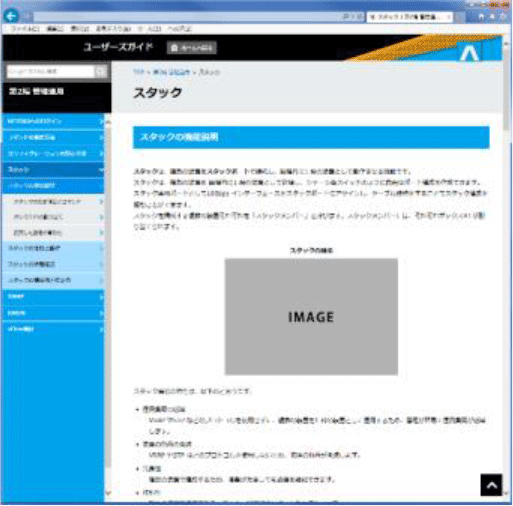
 Sharing of understanding among stakeholders
Sharing of understanding among stakeholdersWe share the understanding of design achievable through DITA, actual operational methods, advantages and disadvantages among stakeholders.
By taking this step, you can prevent a significant gap from occurring between the completed image and the actual outcome.
Common Understanding to Build
- What can be done with DITA
- What is important
- What must we give up?
- 2. Rule Formulation
-
We create style guides that establish writing and operational rules tailored to each client.
 Key Points for Creating a Style Guide
Key Points for Creating a Style GuideWe customize the standard style guide used by Human Science for each client to create a dedicated style guide.
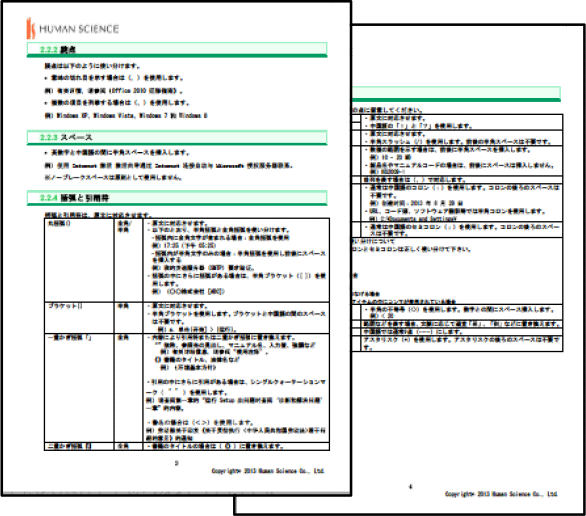
 Do you have any of these concerns?
Do you have any of these concerns?
-
The translation becomes difficult to understand and lacks proper context.
After implementing DITA, the above issues tend to arise during the document translation stage.
 This is how to solve it with human science!
This is how to solve it with human science!
-
To solve this problem, it is important to create a Japanese manual, as well as to establish design and rules, and to operate in accordance with them.
What is specifically needed in that regard is to prepare a "glossary" and a "style guide" in advance.
With Human Science, we can provide one-stop support from the design stage to the actual translation work.
We will maximize the benefits of DITA while addressing challenges such as cost reduction and shortening delivery times.

- 1. Rule Formulation
-
We prepare glossaries and style guides for English translation and multilingualization.
[Sample Example]
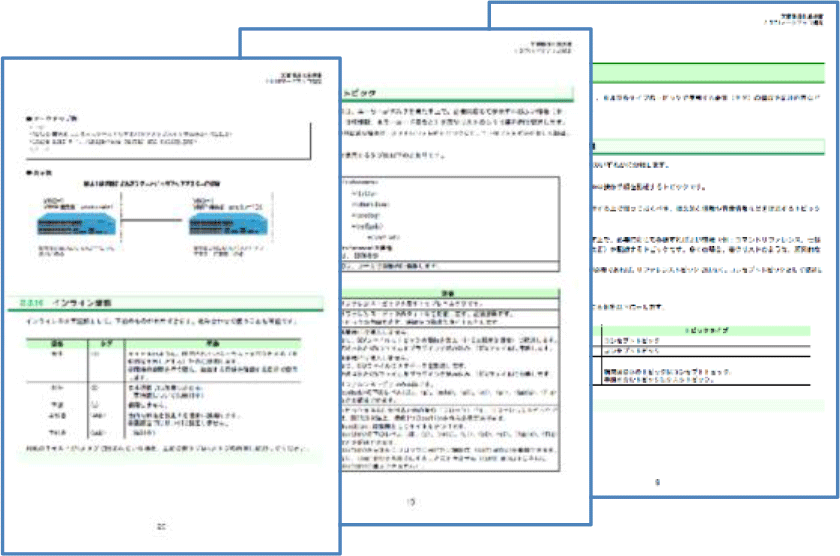
We design differentiation and output branching by language.
 Do you have any of these concerns?
Do you have any of these concerns?
-
"We have implemented DITA and CMS, but the operation is not going well"
"The skills in topic writing are low, and the quality of the manuals is not very good"
DITA and CMS are not the end goal of implementation. After starting operations, various challenges may arise. The above are typical examples of those challenges.
 This is how to solve it with human science!
This is how to solve it with human science!
-
To maximize the benefits of DITA implementation, it is essential to adhere to operational rules.
If operational rules are not clearly defined, data will not be managed properly, and the full benefits of the implemented DITA and CMS will not be realized.
At Human Science, we establish operational rules for DITA and CMS, and support the process of making improvements as necessary.
In addition, improving topic writing skills is essential for DITA technology.
By utilizing the HS writing skills improvement seminar led by instructors with extensive writing experience, you can enhance your writing skills.

We support a process to continuously improve operational rules to maximize the benefits of DITA and CMS implementation. Additionally, we hold practical seminars in workshop format to enhance user skills.
[Example of Seminar Curriculum]
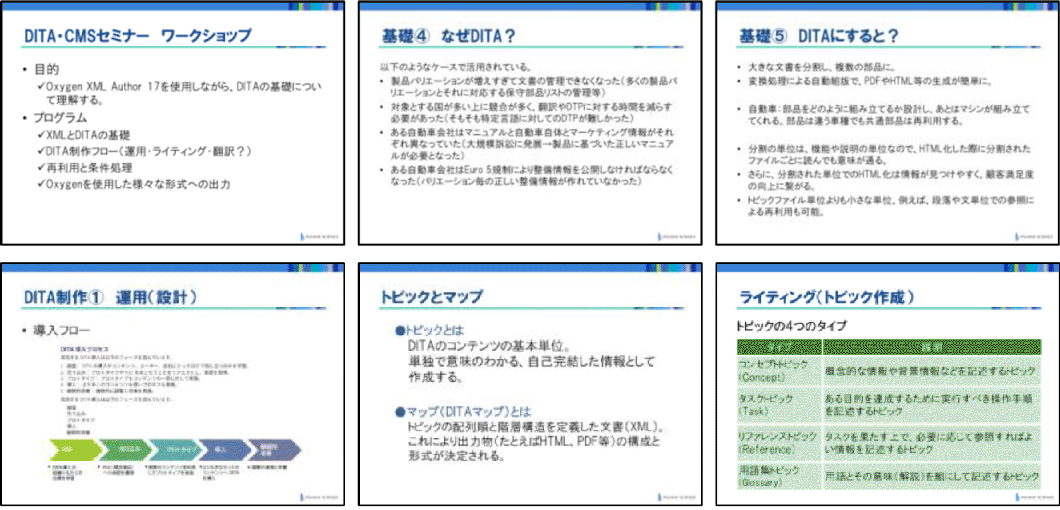
Cost Estimate
We will provide a customized estimate.
Please feel free to contact us.


